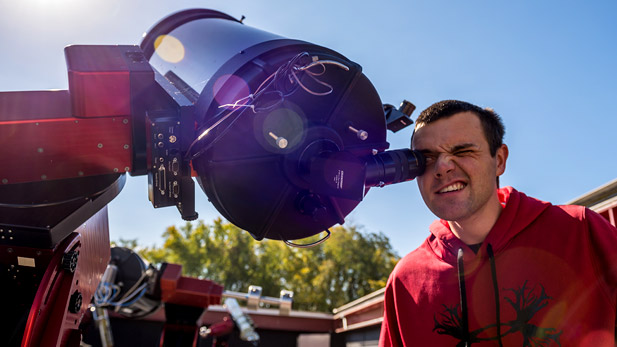Mercury Transit Can Be Viewed Monday at Rose-Hulman’s Oakley Observatory

On Monday, November 11, seven telescopes with solar filters will be focused on the transit of Mercury, the innermost planet of our solar system, starting at 8 a.m. and continuing until approximately noon, weather conditions permitting viewing.
Rose-Hulman Institute of Technology’s Oakley Observatory will help Wabash Valley residents safely view a rare astronomical event on Monday, Nov. 11, when Mercury passes directly in front of the sun. The viewing event is free and open to the public.
Seven telescopes with solar filters will be focused on the transit of Mercury, the innermost planet of our solar system, starting at 8 a.m. and continuing until approximately noon, weather conditions permitting viewing.
The sun is dangerous to view without special equipment, and Mercury’s diameter is miniscule when compared to the sun. Therefore, Oakley Observatory Director Dominic Ludovici recommends seeing the transit through Rose-Hulman’s telescopes, which have a magnification of 50 to 100 times and protect the viewer’s eyes from damage.
The physics and optical engineering professor and Rose-Hulman students will be available to assist people in viewing the unique spectacle in a safe manner.
“This is a rare feat since another Mercury transit won’t be seen from Earth again until 2032,” Ludovici says.
Guests to the Oakley Observatory must park in a lot off Rose-Hulman’s east entrance from Hunt Road, north of the intersection at U.S. 40/Wabash Avenue (near Lost Creek Elementary School). People can then walk a short distance up a gravel driveway to the base of the observatory. The facility is elevated, and its roof will be open to provide open viewing from any of the telescopes.
The Oakley Observatory was founded at Rose-Hulman in 2000 through support from the Hollie and Anna Oakley Foundation, Inc. of Terre Haute. Students utilize telescopes at the Oakley Observatory and Oakley Southern Sky Observatory, established by the foundation in 2007 near the Australian outback, for classroom, laboratory, special research projects, and Astronomy Club activities.